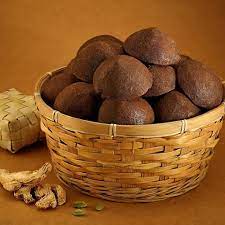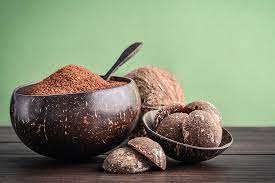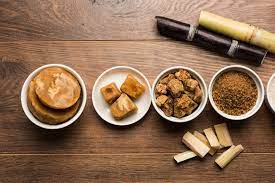Walk through any Indian marketplace and you’ll spot stacks of jaggery cubes or molds. This unrefined cane sugar is a favorite sweetener and flavoring agent. But while most gur comes from sugarcane, you can also find it made from palm sap.
So what’s the difference between traditional sugarcane jaggery and palm jaggery? Is one healthier or tastier? Let’s compare these two types of gur in-depth.
What is Palm Jaggery?

Palm gur , also called palm sugar or panang kalkandu, is made from the sap of palm trees, primarily:
- Palmyra palms – Borassus flabellifer
- Coconut palms – Cocos nucifera
- Date palms – Phoenix dactylifera
To make palm gur , farmers tap unopened flower buds to drain the sweet sap. This sap is boiled down to produce a brown, creamy gur or a solid block.
Palm gur has traditionally been made in coastal states like Kerala, Tamil Nadu, and Karnataka. It has a subtle caramelized flavor when compared to sugarcane jaggery.
Now let’s see how sugarcane gur stacks up against this variant.
Sugarcane Jaggery vs. Palm Jaggery

| Parameter | Sugarcane Jaggery | Palm Jaggery |
|---|---|---|
| Source | Sugarcane juice | Palm sap |
| Glycemic index | Medium (~65) | Low (~35) |
| Calories | ~380 kcal per 100g | ~353 kcal per 100g |
| Minerals | Contains iron, magnesium, potassium | Rich in potassium, iron, phosphorus |
| Production | Made year-round | Seasonal, tapped only during flowering |
| Flavor | Robust, toasty, bitter | Mild, sweet, hint of caramel |
This makes their nutritional profiles and production clear. Let’s analyze the key points of difference:
Glycemic Index
Palm gur has a much lower glycemic index than sugarcane. So it provides a slower, more gradual energy release instead of a blood sugar spike. This makes palm gur a better choice for diabetics or weight watchers.
Mineral Content
Both contain a wealth of minerals like iron, potassium, and magnesium. But palm jaggery offers even more micronutrients as it retains almost all the palm sap’s nutrients.
Production
Sugarcane gur can be made year-round as sugarcane is harvested almost continuously in tropical regions. But palm gur .production is seasonal and matched to tree flowering cycles. This makes it more limited in supply.
Flavor
While sugarcane gur is quite robust, palm jaggery has a delicate sweetness reminiscent of caramel. Its light color also gives it a blonde tinge rather than brown.
Health Benefits of Palm Jaggery

Apart from minerals and low glycemic index, palm gur provides many other health benefits:
- Excellent iron source to prevent anemia
- Rich in phytochemicals like polyphenols with antioxidant effects
- Contains inulin, which acts as a prebiotic for gut health
- Has a cooling energy in Ayurveda, so soothes inflammatory conditions
Traditionally, palm gur is considered beneficial for the stomach and liver. Its rich mineral content boosts hemoglobin, immunity and vitality.
Culinary Uses
Both jaggeries can be used in similar ways in cooking:
- Sweetener for drinks like tea, coffee, lemonade
- Blended into desserts like halwa, kheer, ladoos
- Flavoring agent for curries, dals
- Toppings for snacks like sevai
However, palm gur stands out for its unique caramel aroma. It is used in premium sweets like Mysore pak, Palkova, and sweet Paan.
The Verdict
So in this battle of jaggeries, is there a clear winner?
For health benefits and low glycemic impact, palm gur wins over sugarcane. Its unique taste and seasonal availability also make it a more prized variant.
However, sugarcane gur is easier to produce year-round. It offers a robust, familiar flavor that works well in both sweet and savory recipes.
Ideally, consume both jaggeries in moderation to benefit from their respective nutritional goodness! Choose sugarcane jaggery for daily use, and enjoy palm gur as an occasional treat.
What’s your take – do you prefer one variant of gur ? Share your experiences and recipes using these sweeteners! Let’s have a fruitful discussion on the pros and cons of each type of this.








